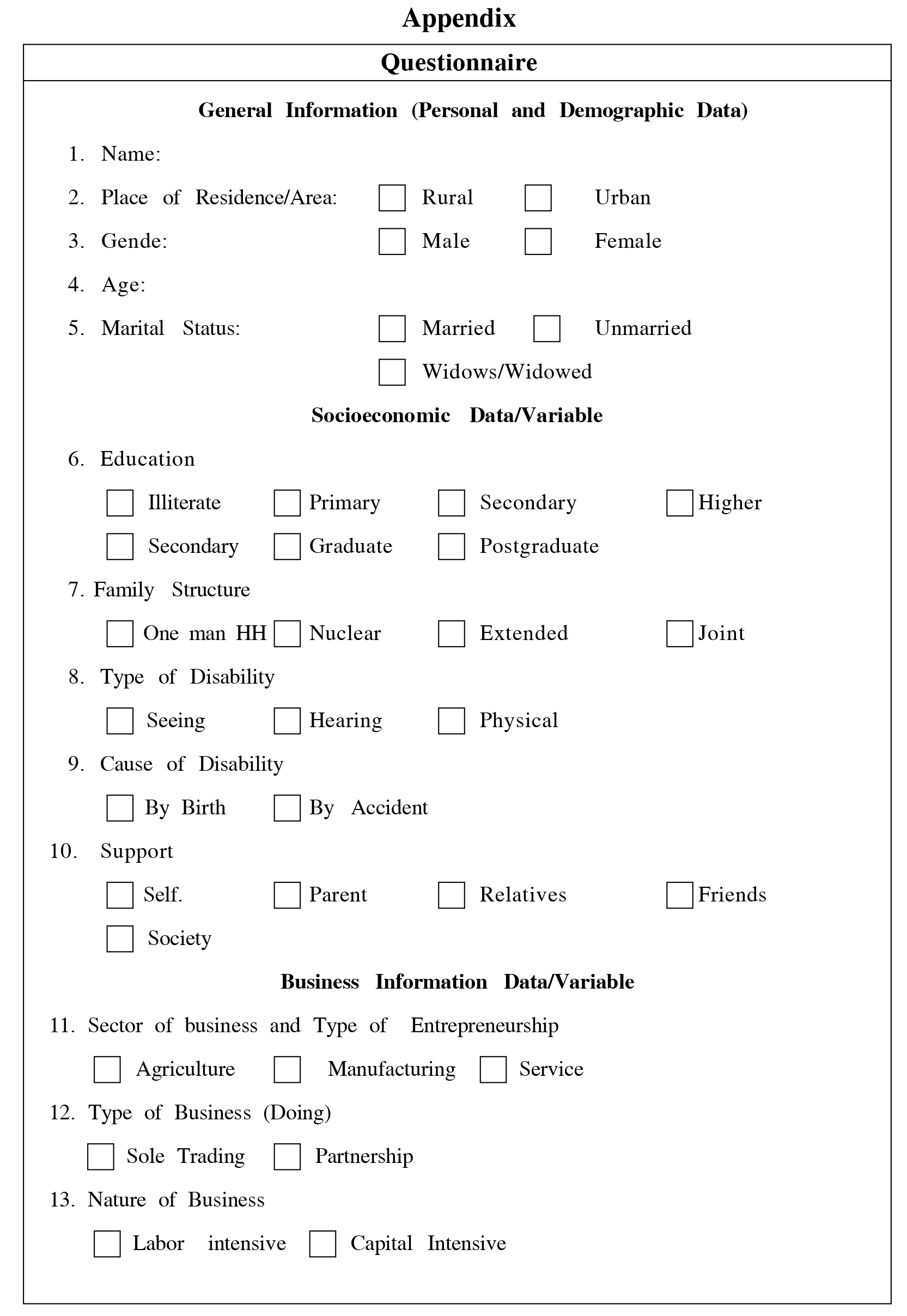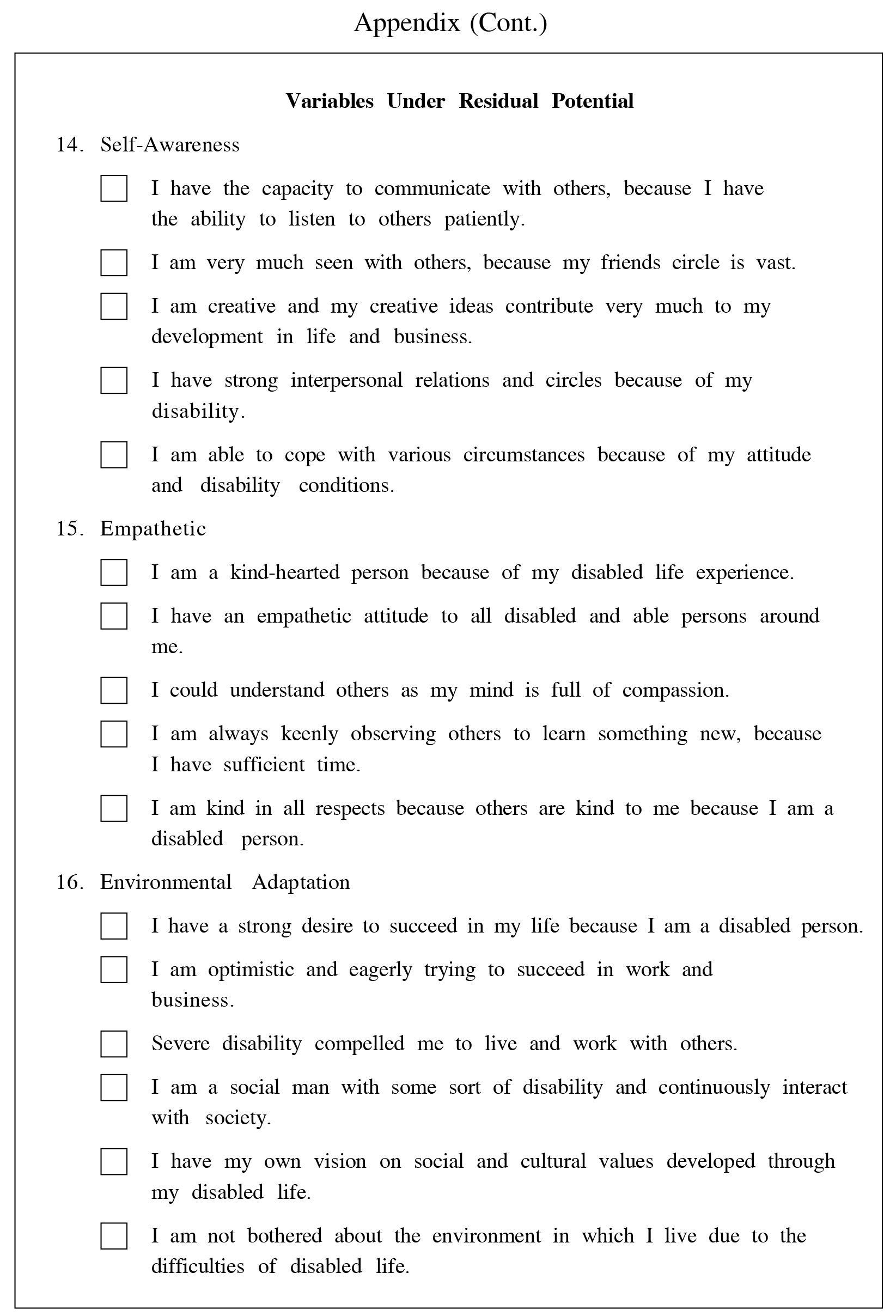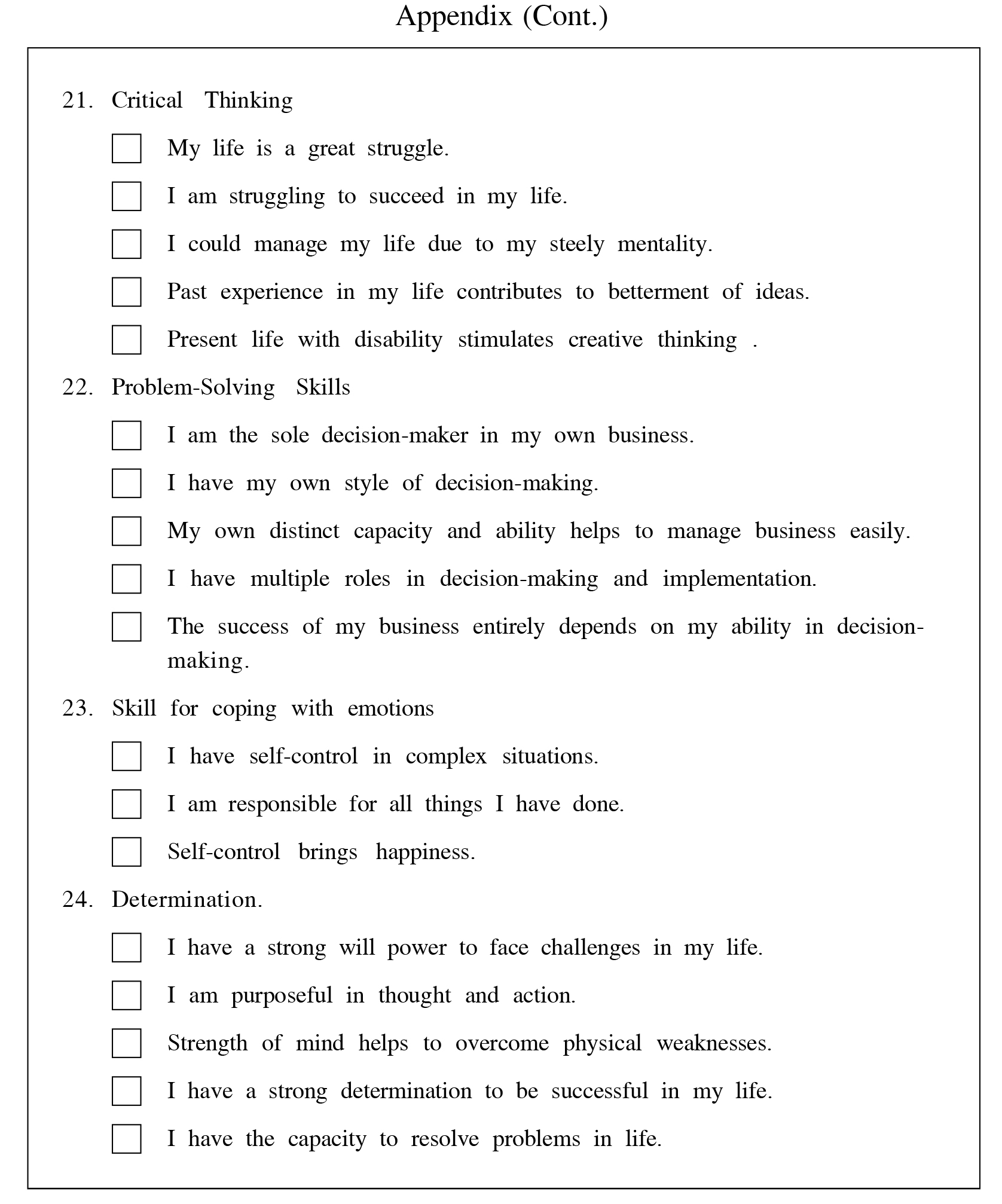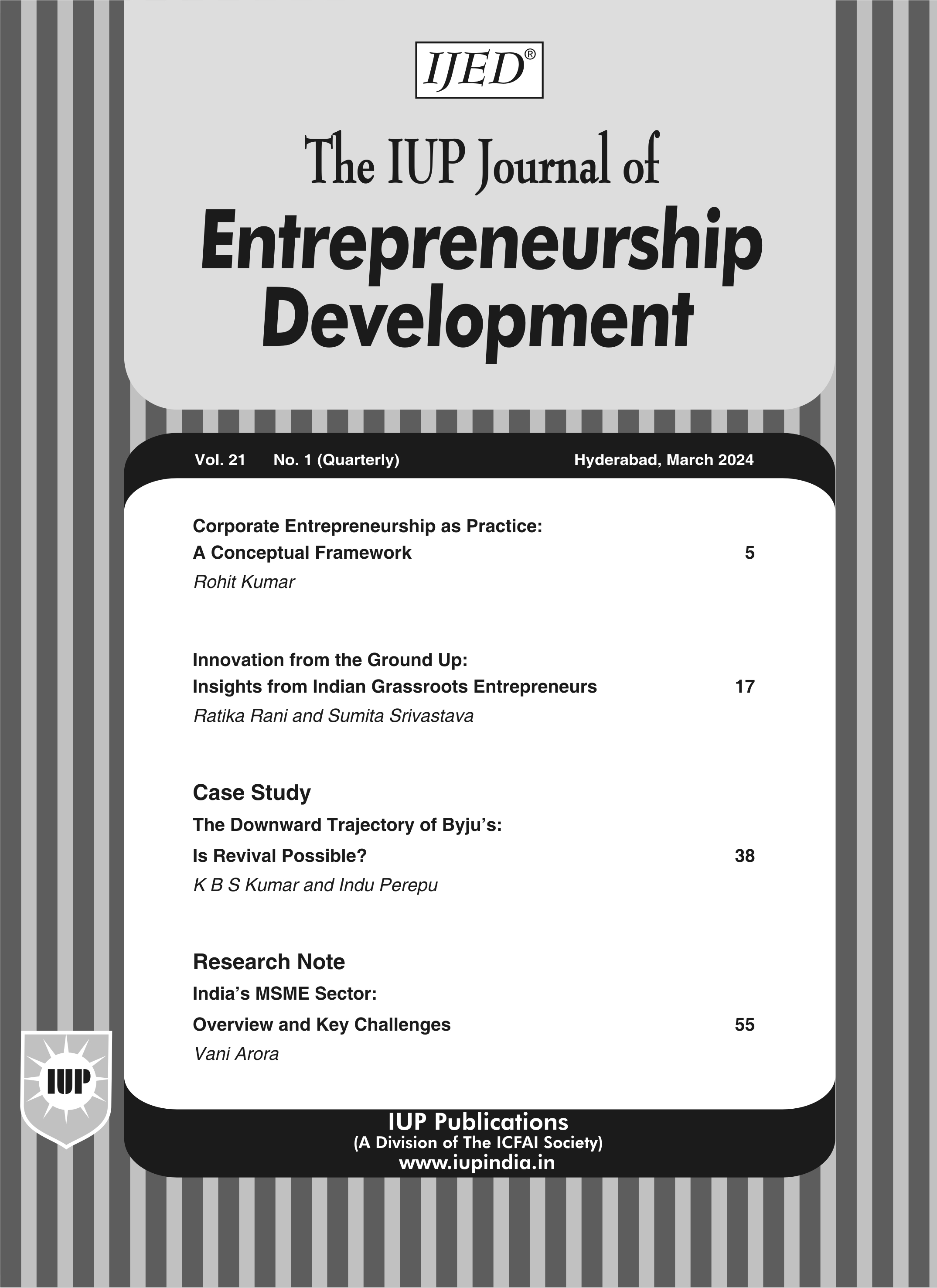
June'22
The IUP Journal of Entrepreneurship Development
Archives
A Study on the Relative Influence of Residual Potential and Educational Status of Differently-Abled Entrepreneurs in India ? 2022
Shanimon S
Assistant Professor of Commerce, Government College Attingal, University of Kerala,
Thiruvananthapuram, India; and is the corresponding author. E-mail: shanimonimon@gmail.com
Sunil S
Assistant Professor of Commerce, Government College Attingal, University of Kerala, Thiruvananthapuram,
India.E-mail: sunilayilamap75@gmail.com
Jaseela Thanikkad
Assistant Professor of Commerce, Government College, Kannur University, Mananthavady, P.O Nallurnad,
Wayanad, Kerala, India. E-mail: jaazthanikkad@gmail.com
Entrepreneurship is the process of starting a new business or enterprise. Entrepreneurs initiate change in the structure of business and society. This change is accompanied by growth and increased output, which allows more wealth to be divided between the various participants. Thus, entrepreneurship increases the national income and enhances economic development. It can be looked upon as a means of income generation and development. The role of entrepreneurship development is very important in the economic and social development of several sections of people, especially women and socially marginalized groups of Scheduled Castes, Scheduled Tribes, and differently-abled people. They bring economic growth to a country and society at large. Entrepreneurship development is a tool to overcome poverty, unemployment, economic underdevelopment, and social exclusion. This study analyzes the functional relationship between the residual potential of differently-abled entrepreneurs, their educational status, and entrepreneurship development.
Introduction
In India, the evolution of entrepreneurship can be traced back to centuries-old handicrafts, craftsmen and entrepreneurial people in the village community. The caste-based workers such as farmers, artisans, priests were considered as a compact system of village community. The actual emergence of manufacturing entrepreneurship in India was in the second half of the 19th century under British rule although prior to 1850, some stray attempts were noticeable in the various kingdoms. Entrepreneurship development is one of the factors influencing economic development, and it increases the real per capita income of a country.
An Entrepreneur?s experiences, skills and competencies attained through educational environment are widely accepted as influencing factors of entrepreneurial behavior and business development. Educational qualification, the nature and type of education, has a direct impact on entrepreneurial processes and entrepreneurial behavior. Perceived deprivations experienced in the early childhood can influence one's own personality. Educational status would always improve one's performance in life. The education level of an individual motivates him to go for a career option that would result in the emergence of a new venture creation.
Statement of the Problem
Persons with disabilities constitute 15% of the world's population (Hameedu, 2014), of whom 80% live in developing countries. Disability leads to poverty and thereby lowers the income of individual and households. Disability and resultant poverty worsens the standard of living of persons with disability. Disability may lead to limited employment opportunities and earnings to persons with disability and other family members due to care for disabled family member (Meyer and Mok, 2008). Disability may prevent better employment opportunities or constrain the kind of work a disabled person can do (Evans, 1989; and Sen, 1992). Disability may limit human capital development and opportunities for social development. Despite medical advances disability is rising. Disability rates are significantly higher among groups with lower educational attainment in various countries. Women and children report higher incidence of disability than men. Women with disabilities are recognized to be more disadvantaged. Skill development and entrepreneurship development are essential for the development of socially and economically disadvantaged groups.
Objective
The main objective of the study is to identify the residual potential of differently-abled entrepreneurs.
To find out the relative influence of factors of residual potential and educational status of differently-abled entrepreneurs on entrepreneurship development.
Methodology
The present study is an empirical study based on primary and secondary data. For this study, 11 residual potential qualities were identified; these are communication skills; inter personal relationship; critical thinking; creative thinking; problem solving skills; skills for coping with emotions; determination; self-awareness; empathetic; environmental adaptation and sympathy are grouped under residual potential qualities (see Appendix).
Systematic random sampling technique was used for the selection of the sample. In the first stage, an individual sample unit was identified as one who has received financial and entrepreneurship assistance from National Handicapped Finance and Development Corporation and the nodal agencies of the institution. Hence, the list of beneficiaries of financial year 2012-2013 was selected to fix the sample frame; the total number of beneficiaries for the financial year 2012-2013 was 5,039. That number constitutes the total number of differently-abled persons, who have received financial and entrepreneurial assistance only for the period of 2012-2013. In the second stage, based on the pilot study, a sample size was obtained after assuming a 5% error in the estimates of 30 responses using the information on variances. The formula used is n≤; (1.96/d)2. where 'n' is the sample size, 'd' is the standard error of the estimation of population parameter, and the value 1.96 is the critical value from normal test at 5% significance. The sample size of 148 calculated was the maximum among the sample sizes obtained from responses of all the statements. Hence, the sample size was fixed suitably as 150.
Levels of Overall Residual Potential
Residual potential is assessed on the basis of the innate potentialities of differently-abled entrepreneurs. On the basis of descriptive analysis, the relationships of variables are identified based on different levels. The intensity of 11 variables in three levels (low level, moderate level, and high level) under the main variable of residual potential is identified as the basic cause of entrepreneurship development among differently-abled people. Table 1 shows the basis on which the levels of different variables are identified.

Figure 1 shows the percentage values of overall residual potential. Percentage score below 186 constitutes low level; moderate level is the level in between scores 186 to 239, and above the score of 239 constitutes high level of factors of residual potential.
The variations in the level and the respondents having different levels of residual potential determine the capacity buildup of residual potential among differently-abled entrepreneurs.
Education and Residual Potential
Education is important to explore opportunities in human life, especially in the case of the differently-abled. The educational status of differently-abled persons in India is poor compared to that of able-bodied persons. Right to education is a basic right to every person in India. Millennium Development Goal of the UN Conventions ensures universal education.
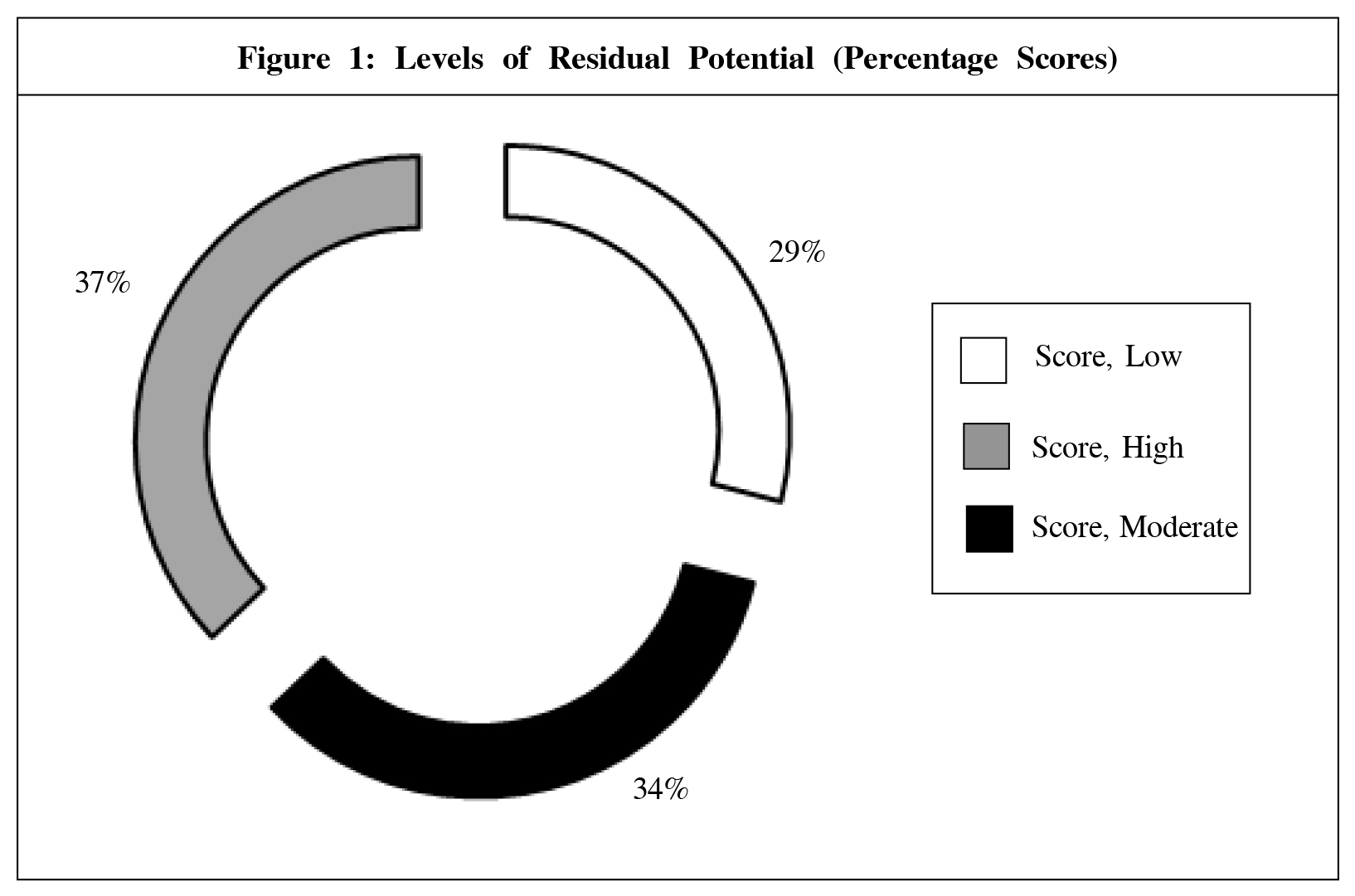
Educational Qualification of Differently-Abled Entrepreneurs and Level of Residual Potential
According to the National Sample Survey Organization, the gender differences in educational attainment among differently-abled people are very high. Effective literacy rate among differently-abled persons in India constitutes 59.0%. Effective literacy rate among differently-abled females and males is 48.4% and 67.3% respectively (Census, 2011). Table 2 assesses the cross-relationship between educational qualification of the differently-abled entrepreneurs and the level of residual potential.
Table 2 shows that a majority of differently-abled entrepreneurs (53.7%) with high level of residual potential have higher secondary education. 17.3% of the respondents are graduates, and out of the total number of graduates, none of the respondents show higher level of residual potential. It may be observed that level of residual potential is decreasing with higher levels of educational qualification. Illiterate people with higher level of residual potential constitute 9.8%, and 29.3% are primary educated with higher level of residual potential. 25.3% of differently-abled entrepreneurs are found to have low level of residual capacity irrespective of their educational status.
To prove the statistical significance of the association between educational qualification of differently-abled entrepreneurs and their residual potential, Chi-square test is applied to prove the following hypothesis:
H01: There is no significant association between educational qualification of differently-abled entrepreneurs and the levels of residual potential.
The test was found to be significant with likelihood ratio of 48.85 and Chi-square value is 0.000 at 5% level of significance (Table 3). Hence, there exists significant association between educational qualification of differently-abled entrepreneurs and level of residual potential.
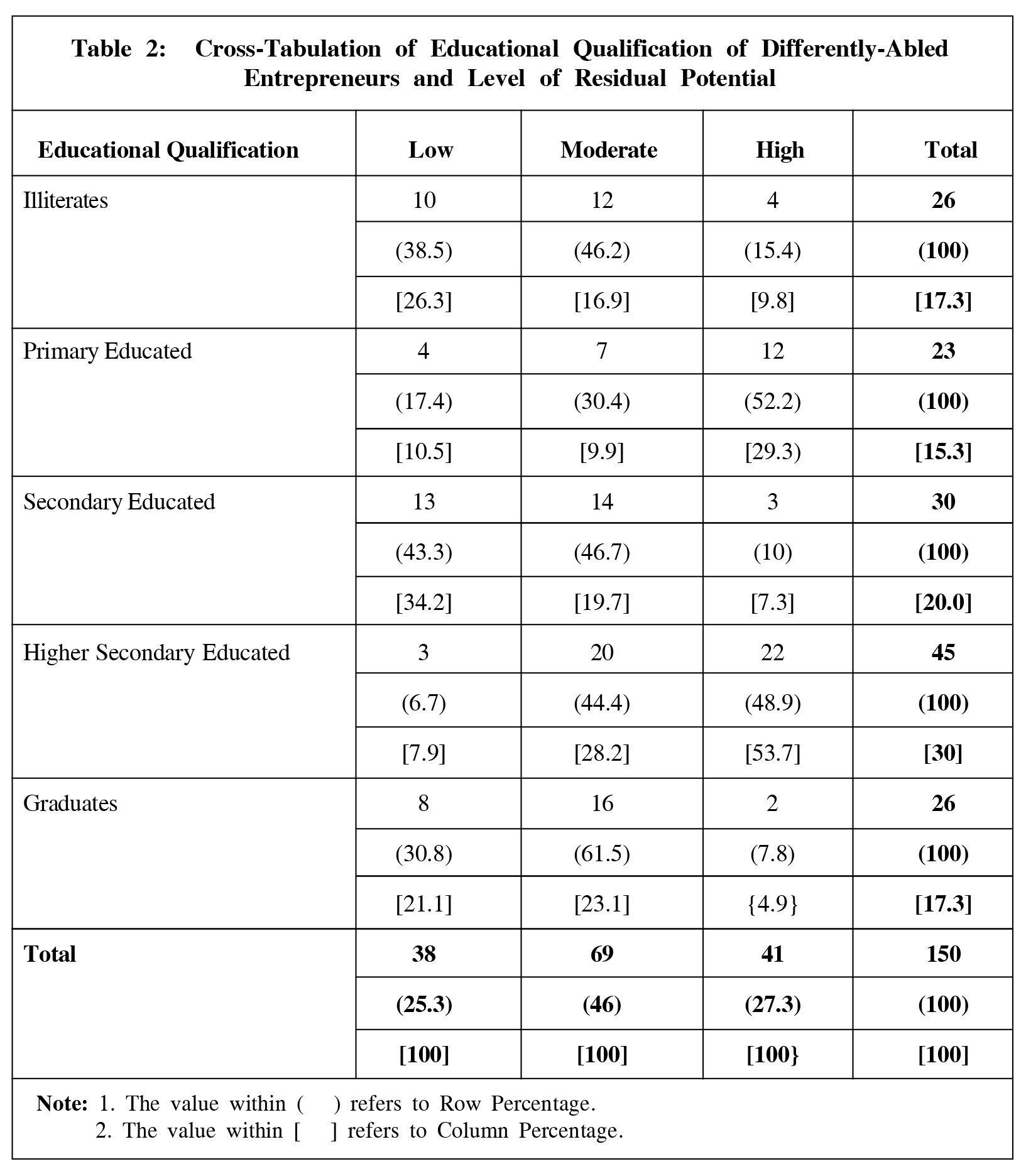
H02: There is no significant difference in mean scores of factors of residual potential among differently-abled entrepreneurs based on educational qualification.
Differently-abled entrepreneurs classified based on education qualifications denotes significance at 5% level using Duncan Multiple Range Test (DMRT).
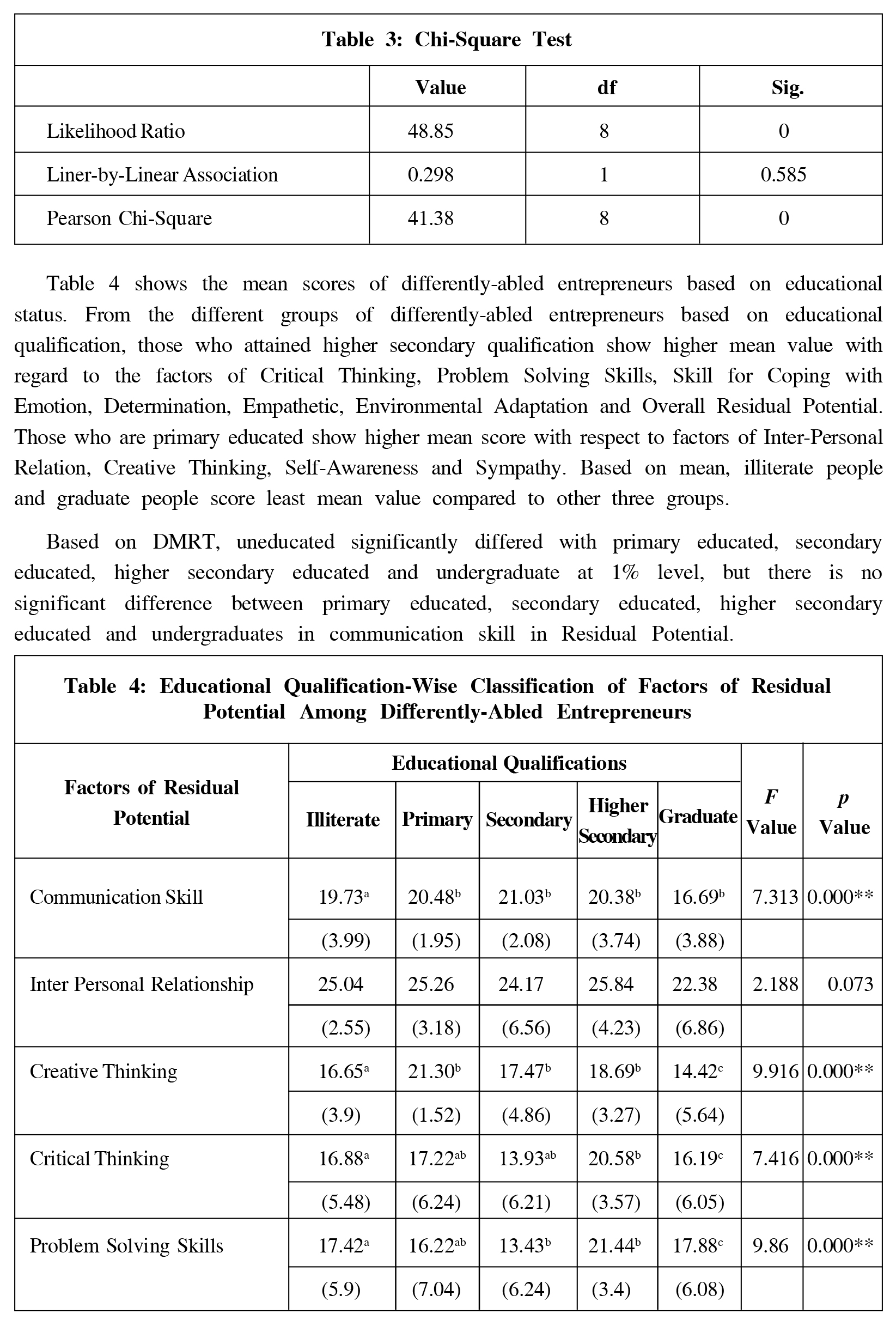
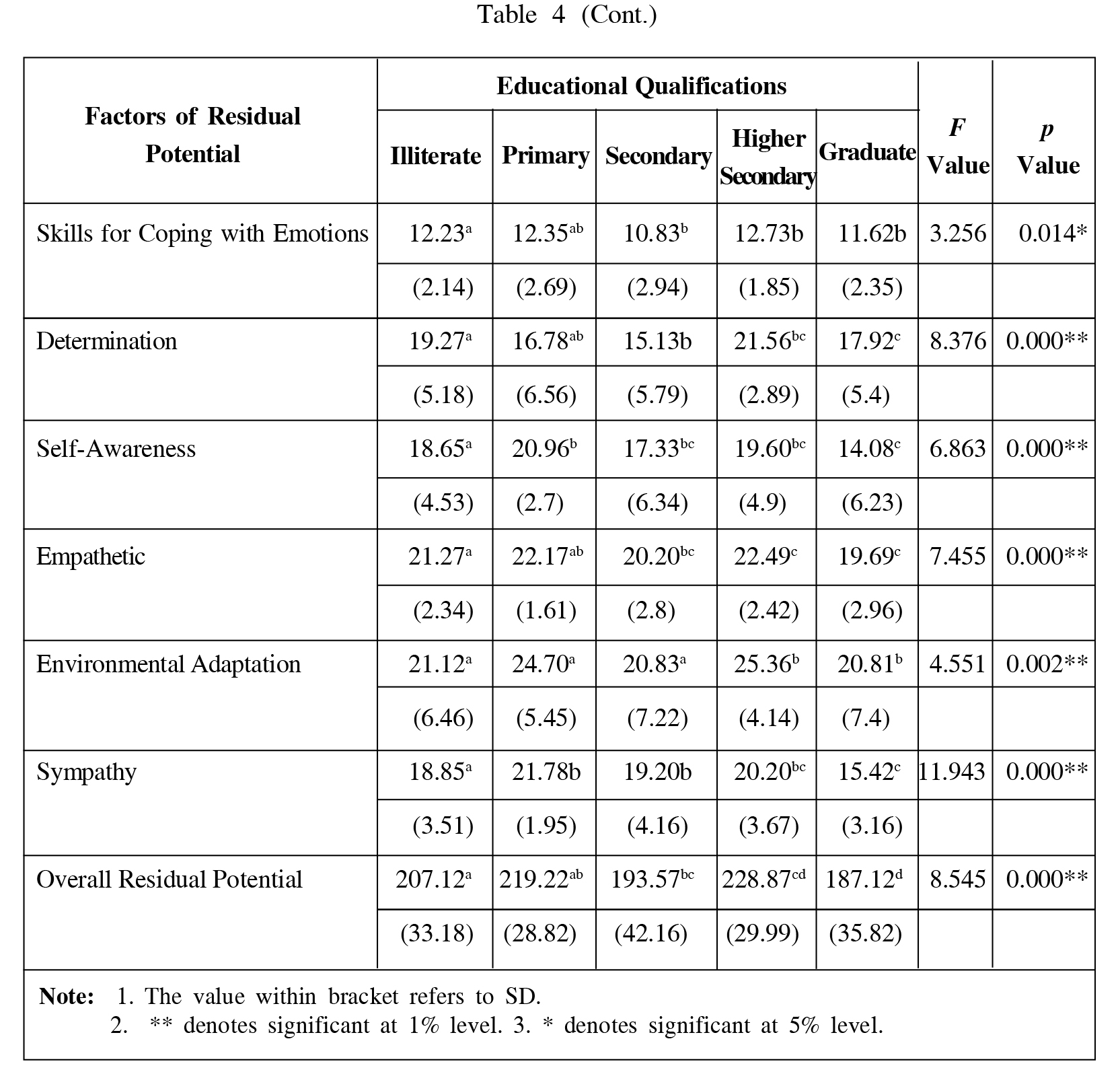
There is no significant difference in educational qualifications of differently-abled entrepreneurs with regard to factors of inter-personal relationship. Since p value is greater than 0.05, null hypothesis is accepted at 5% level with regard to factors of inter-personal relationship.
Multiple Regression Analysis
Regression analysis of the residual potential is done to prove the correlation between entrepreneurship development and factors of residual potential. Eleven residual potential factors are used as independent variables, namely,
- Communication Skill
- Inter-Personal Relationship
- Creative Thinking
- Critical Thinking
- Problem-Solving Skill
- Skill for Coping with Emotion
- Determination
- Self-Awareness
- Empathetic Attitude
- Environmental Adaptation
- Sympathy
Entrepreneurship development is taken as dependent variable.
H03: There is no significant difference in mean ranks on the factors of residual potential among differently-abled entrepreneurs.
Based on mean rank (Table 5), Empathetic Attitude (7.54) is most effective of Residual Potential, followed by Environmental Adaptation (7.42), Since p value is less than 0.001, the null hypothesis is rejected at 1% level of significance. To test the statistical significance, the following hypothesis is tested:
H04: There is no significant relationship between entrepreneurship development and factors of residual potential among differently-abled entrepreneurs.
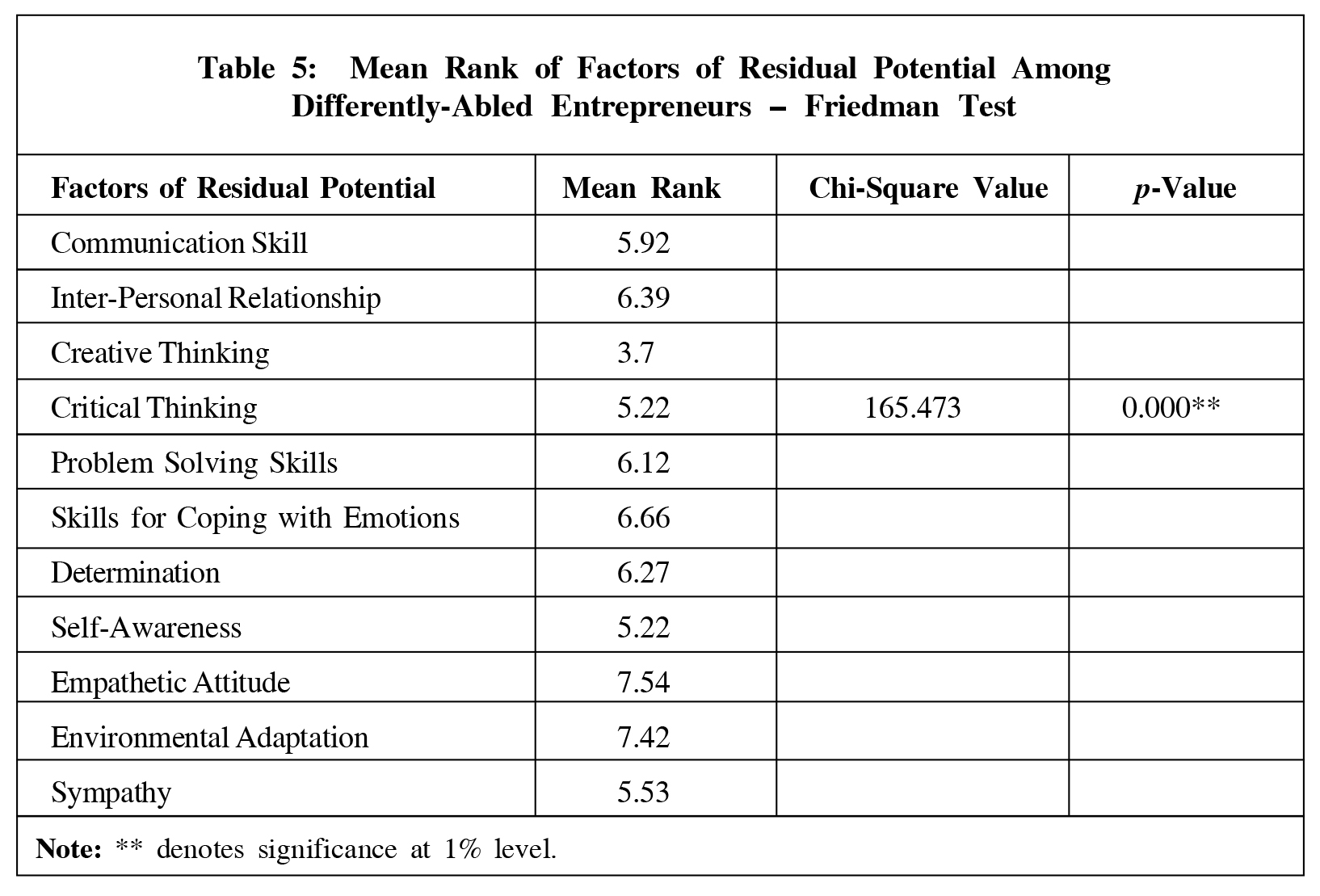
Eleven residual potential factors (Table 5) are used as independent variables, namely, Communication Skill, Inter-Personal Relationship, Creative Thinking, Critical Thinking, Problem-Solving Skill, Skill for Coping with Emotion, Determination, Self-Awareness, Empathetic Attitude, Environmental Adaptation and Sympathy. Entrepreneurship Development is taken as dependent variable. Y = a + b1X1 + b2X2 + b3X3 + b4X4 + b5X5 + b6X6 + b7X7 + b8X8 + b9X9 + b10X10 + b11X11 Overall model (Table 6) is found to be significant. The significant value in the ANOVA table is 0.000 which is less than 0.001. Thus the null hypothesis of ANOVA is rejected (Table 7).
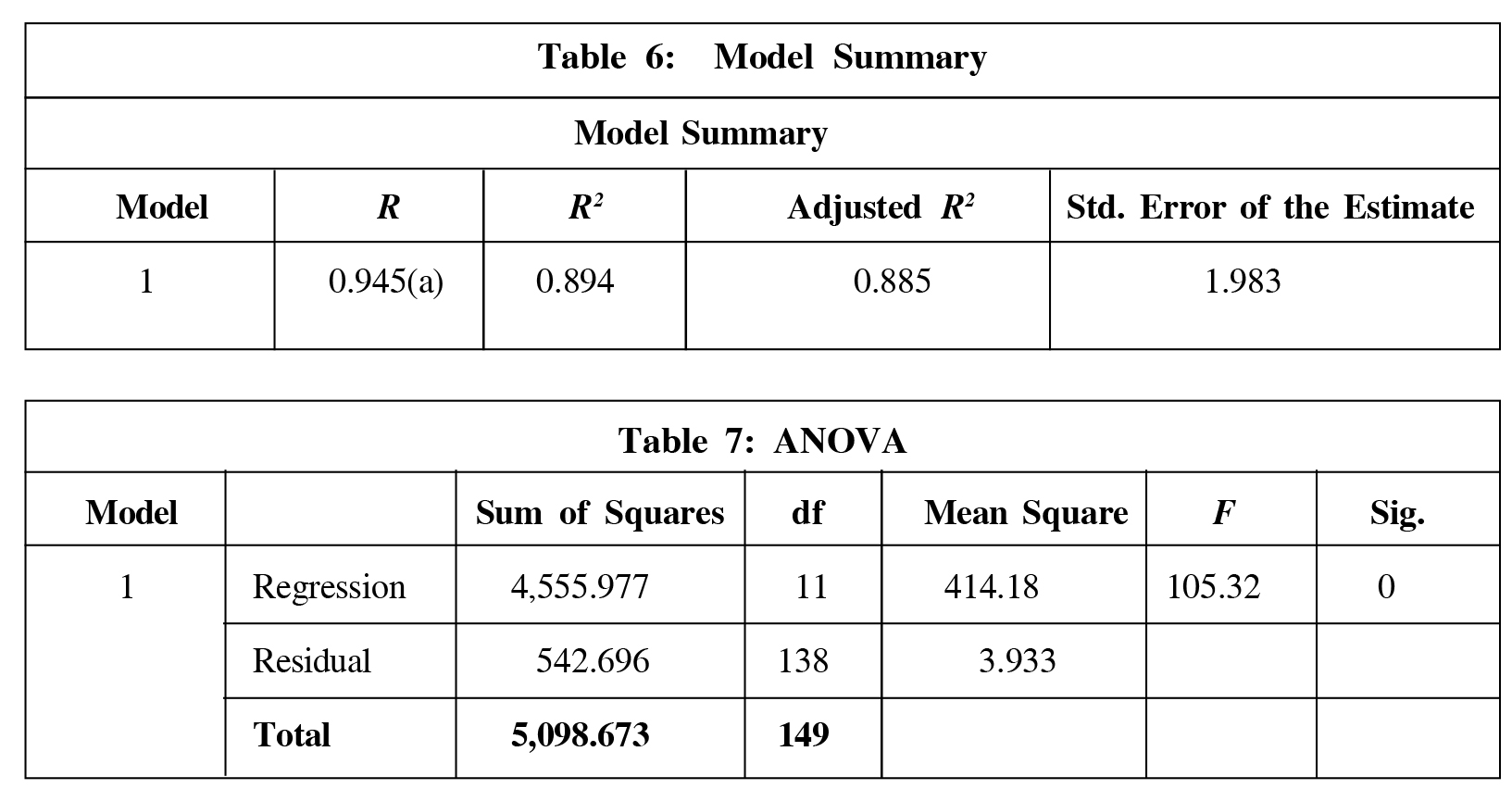
Results
- Final regression model includes Communication Skill, Inter-Personal Relationship, Creative Thinking, Critical Thinking, Problem Solving Skill, Skill for Coping with Emotion, Determination, Self Awareness, Empathetic Attitude, Environmental Adaptation and Sympathy as independent variables to predict entrepreneurship development.
- The overall model is found to be a significant determinant of entrepreneurship development as it has predicted 89% variation in the dependent variable (R2 0.894) (Table 6)
- Out of 11 dependent variables, Creative Thinking, Problem Solving Skill, Skill for Coping with Emotion, Determination, Empathetic Attitude, Sympathy are observed to have no relationship with entrepreneurship development.
- Communication Skill has regression coefficient 0.210, indicating positive relationship with entrepreneurship development. Inter-Personal Relationship has regression coefficient 0.131 indicating positive relationship with Entrepreneurship Development (Table 8).
- Critical thinking has regression coefficient value 0.445, indicating positive relationship with Entrepreneurship Development. Self-Awareness has regression coefficient value 0.470, indicating a positive relationship with dependent variable. Environmental Adaptation has regression coefficient 0.210, indicating positive relationship with entrepreneurship development.
- Every one unit increase or decrease in communication skill will impact the entrepreneurship Development by 0.210 times in same direction, Inter-personal Relationship will impact the entrepreneurship development by 0.131 times in same direction,
- Critical thinking will impact the entrepreneurship development by 0.455 times in same direction, self-awareness will impact the entrepreneurship development by 0.470 times in same direction, Environmental adaptation will impact the entrepreneurship development by 0.210 times in same direction.
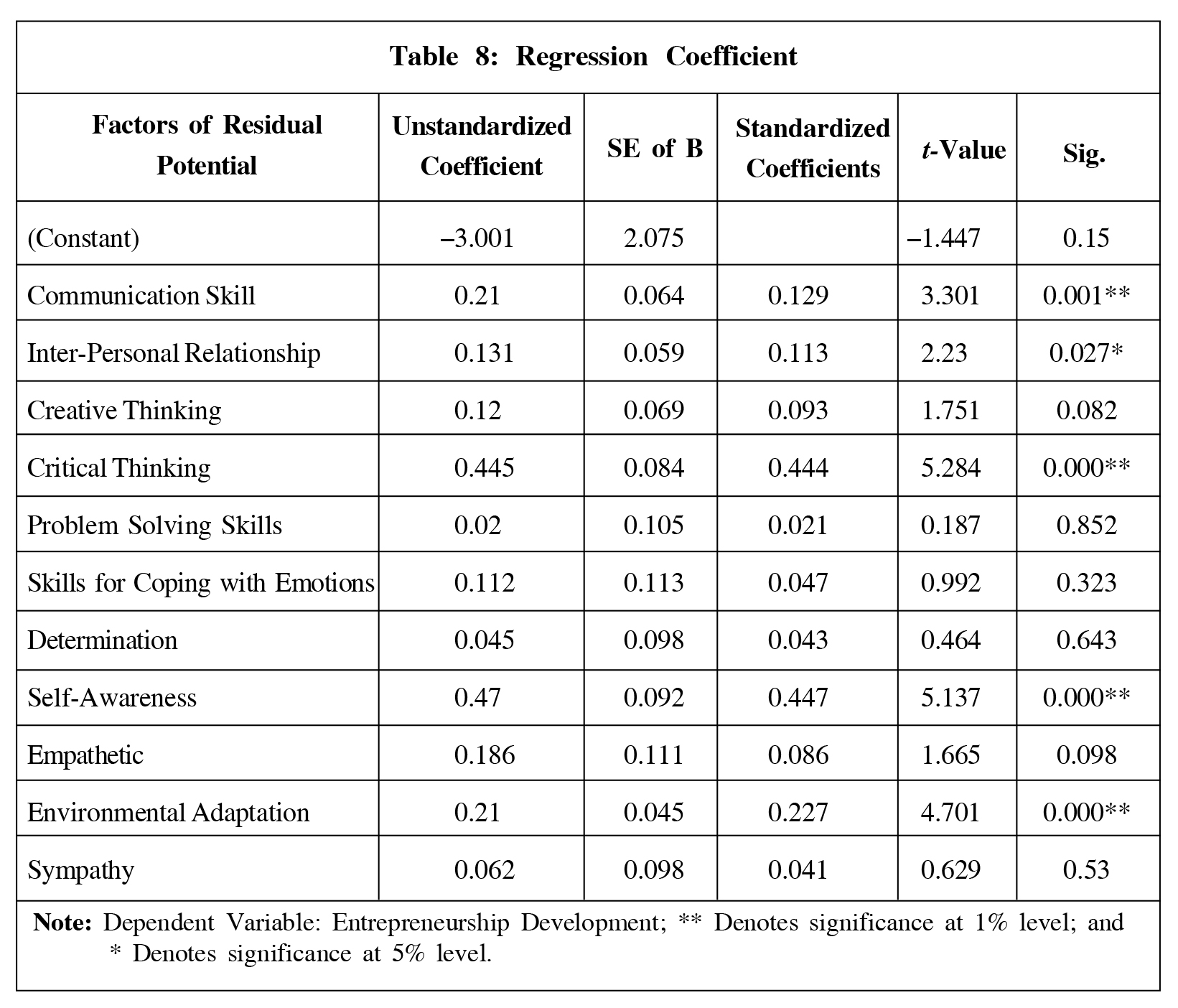
Conclusion
Entrepreneurship development among differently-abled entrepreneurs is affected by many factors, viz., communication skill, inter-personal relationship, critical thinking, self awareness and environmental adaptation, which are the most important positively influencing factors of residual potential. Residual potential of an entrepreneur refers to the innate qualities other than basic entrepreneurial qualities, especially in the case of differently-abled entrepreneurs. We can conclude that differently-abled entrepreneurs can do extremely well in entrepreneurship development because of their own innate potentialities and they are bestowed with certain innate qualities called Residual Potential.
References
- Hameedu (2014), "The Emerging Development Model in India-Differently Abled Entrepreneur", International Journal of Scientific and Research Publication, Vol. 4, No. 1.
- Sen A (2002), "Globalization, Inequality and Global Protest", Development, Vol. 45.
- Evans (1989), Bias in Human Reasoning Causes and Consequences, Lawrence Erlbaum Associates., Inc.
- Meyer Bruce D and Mok Wallance KC (2019), "Disability, Earnings, Income and Consumption", Journal of Public Economics, Vol. 171, pp. 51-69.
- Evans S (1989), "An Essential Model of Entrepreneurial Choice under the Liquidity Constraints", Journal of Political Economy, Vol. 97, No. 4, pp. 15-21.
